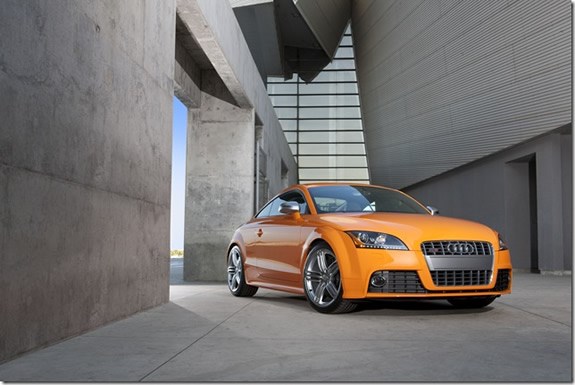2010 Audi TTS 2.0 TFSI Quattro S-Tronic Coupe
Just telling someone the name of this car could make you winded.
Just telling someone the name of this car could make you winded. But given how good a car it is, it would trip off your tongue with glee. . . .
It is a small part of an automotive interior. Often overlooked. Sometimes it is respectable. Sometimes it is trivial. Sometimes it is completely eliminated: After all, it isn’t something that you readily notice unless you look for it, and as we all know, automakers are all about putting money where they think people will look and subtract it where they won’t.
But don’t you have to ask yourself that if they skimp on this, they might be cutting some corners elsewhere? Ostensibly invisible corners, but edges nonetheless.
What I am talking about is the “dead pedal,” that place where you place your left foot. In the case of the Audi TTS, this could be called the “dead plate,” with “plate” as in the stuff that they make tanks out of, not crockery. But that would be if they made tanks out of brushed aluminum. It is a substantial, perforated place to put your foot. Down in the footwell or not, it isn’t something that they turned a blind eye to (as in those OEMs that eliminate them, thinking, “Aw, it doesn’t do anything, anyway”) or wink at it (as in those who seemingly over-mold a bit of vinyl over the carpeting and call it good).
It is in the little things—like the dead pedal-though which you can get a sense of how serious a manufacturer is about its products. And arguably Audi is very serious about how well engineered its cars are.
///

This is the second-generation Audi TT. The original concept was revealed in 1995—somewhat surprising in its stylish simplicity—and the first production version launched in 1998. This version has been around since 2006. The design changes were such that it is clear what the car is. There is refinement, not revolution. Which speaks well of the original design, which still looks fresh, even though if you think back to products from circa 1998 (e.g., cell phones the size of paperback books), you’ll realize that good design has legs.

As this is the “S” model—Audi’s designation for sport models—it has amped up performance, as in its turbocharged 2.0-liter direct injection engine that provides 265 hp and 258 lb-ft of torque, which is 65 hp and 51 lb-ft more than is provided by the engine found in the standard TT.
///
So what does the engine, the S tronic dual clutch transmission (drive it as an automatic or use steering wheel pedals or the gear shift level for manual shifts) and Quattro AWD do for you? How about a reported 0 to 60 in 4.9 seconds. And a respectable 21/29 city/highway mpg.
In fact, one of the gauge options in the rectangular section of the instrument cluster flanked by the large tachometer and speedometer allows you to measure your lap times. Yes, lap times.

However, chances are most people are not going to be throwing the car around Road America, to say nothing of the Nurburgring. However, they are likely to be pulling off of a ramp on I-75, and doing so at speeds that would otherwise be wide-eyed and white-knuckled, but which can be taken with confidence and coolness thanks, in part to a sport-tuned suspension (MacPherson strut in the front; four-link in the rear) as well as a magnetorheological continuously adaptive damping system (which basically uses magnetism to smooth out the bumps—seriously: magnetism).
And even though G-forces are G-forces, your bottom will stay planted in the sport seats, as the Alcantara inserts provide sufficient comfortable friction.

When you’re doing your daily drive, it is a whole lot more fun, a bright spot in what might otherwise be a crappy commute.
And if it matters—and it probably will, given that you’ve opted for the high-performance TT, which has a base MSRP of $45,900, so if you’re going to spend it, show it—there are standard features, like quad pipes in the back, aluminum-colored side mirrors, very remarkable LED daytime running lights, and an automatic power retractable rear spoiler.
///
Which brings me back to the dead pedal. Back to the serious engineering. And back to the preceding paragraph, where the base price is noted. Throw in the optional 19-in. alloy wheels and summer tires for $800 and the $825 destination charge, and you’re looking at $47,525. You could buy multiples of any number of far lesser cars for that. But that’s the thing: they’d be lesser cars.
The truism “You get what you pay for” is, well, true.
And if you’re looking for “Truth in Engineering,” the translation of the Audi slogan (“Vorsprung durch Technik” sounds cooler, even if you don’t know what it means), well, here it is.

Selected specs:
Engine: 2.0-liter turbocharged in-line four with direct injection
Engine material: cast-iron block; aluminum head
Horsepower: 265 @ 6,000rpm
Torque: 258 lb-ft @ 2,500 to 5,000 rpm
Transmission: Six-speed, dual clutch automatic
Wheelbase: 97.2 in.
Length: 165.3 in.
Height: 53 in.
Width: 72.5 in.
Fuel economy: 21/29 city/hwy mpg
Base MSRP: $45,900


.jpg;width=70;height=70;mode=crop)